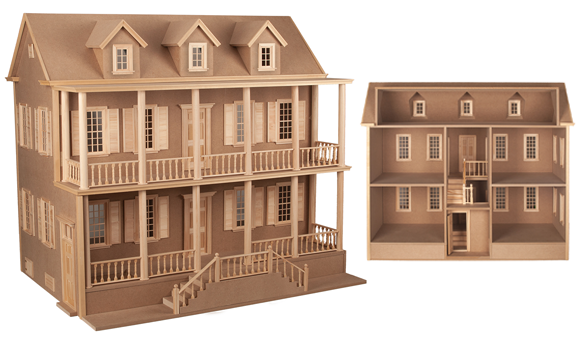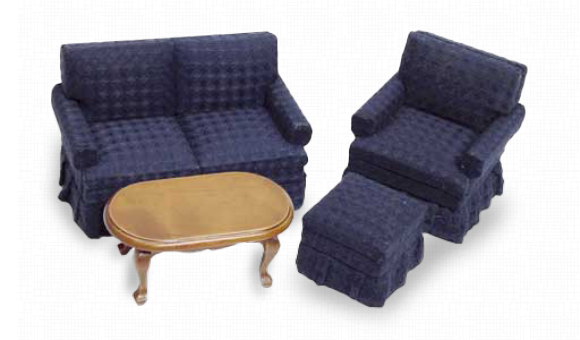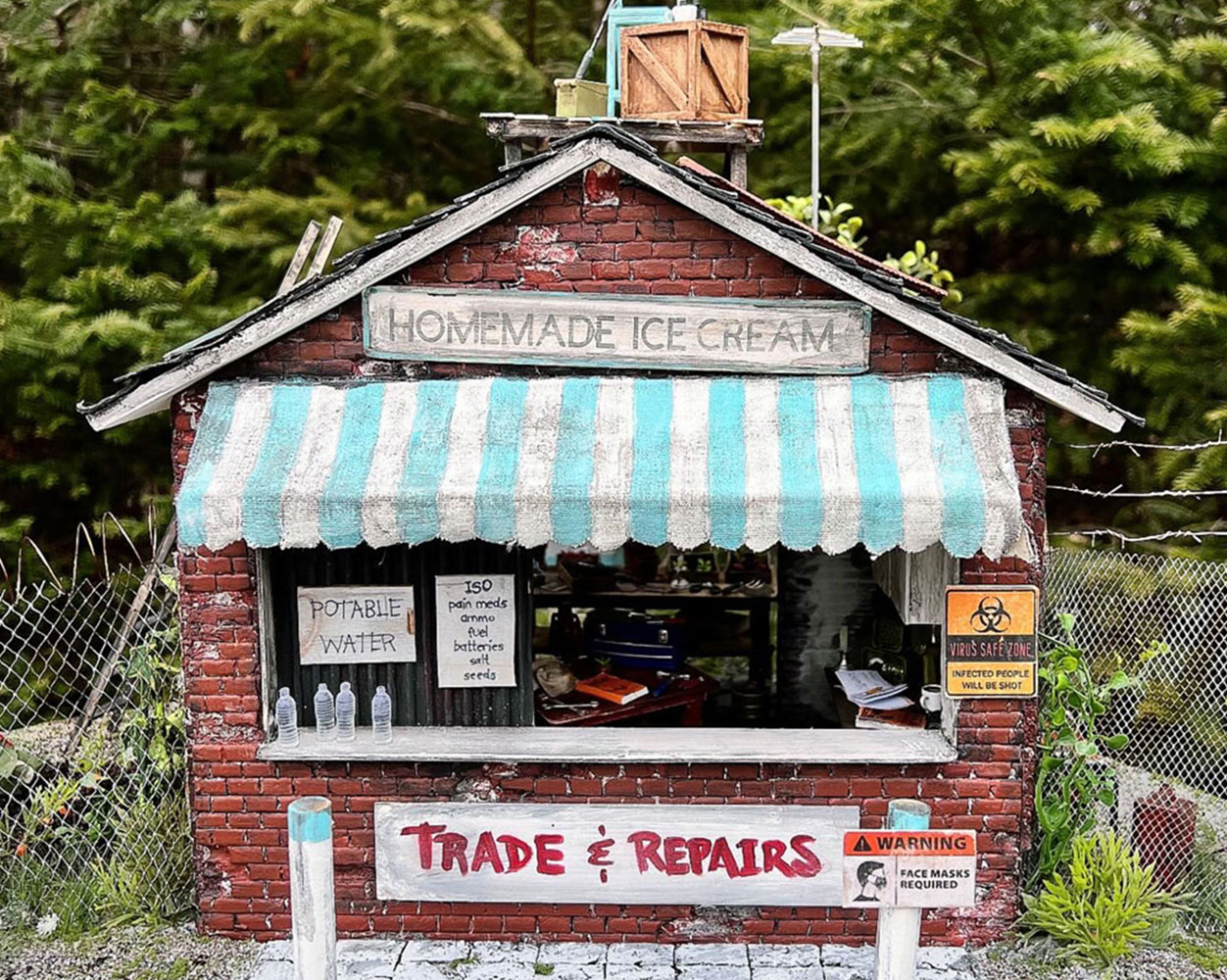by Sally Cook-Thomas

I used two Center Circle Brick Patio Plastic Veneer sheets (item #10351) to cover the Base of the Gazebo. One sheet provides the center design and surrounding bricks. The second sheet completes the edges.
Two Criss-Cross Brick Patio Plastic Veneer sheets (item #10321), cut into strips, cover the step tops and fronts. These sheets are easy to cut with scissors. Cut down the size of the central circle until it fits inside the width of the base, lay it on top of four shortened corners and trace its edge with a pencil. Use the pencil guideline to cut the corner pieces to fit.
Before gluing down the veneers, make a guide for the Column holes. Use a scrap of paper with its sides lined up with a corner on the top of the Base. Gently trace over the paper with a pencil until you feel the two holes underneath and then press the pencil tip into one of them and move it around so that the hole in the paper is the size of the hole in the Base. Repeat for the second hole. One guide will work for each corner set of Columns. Set this guide aside to use later.
Use Omni-Stick™ glue (item #5515) to adhere the veneer pieces to the Base. It is essential to use a glue that will not erode and bubble the plastic veneer. Spread the glue evenly using a scrap of poster board, position the veneer piece, hold in place with masking tape and weigh down evenly with stacks of books. Let the glue set overnight. Remove the masking tape.
In a well-ventilated area, spray paint the entire base in the brick color of your choice. It is better to apply a light first coat, let it set and then apply a full second coat. Let dry 24 hours.
Use your corner guide to discover the holes in the Base that are hidden under the veneer layer. Press the tip of a sharp craft knife thru the veneer, cutting one slot and then cross cut a second slot. Remove the paper and cut away the veneer until the hole is clear. Repeat the process on all eight holes.
Use a small spatula or clay knife to scoop Mortar Mix (item #2076) out of its jar and spread thinly over the Base and its steps. Be careful not to scrape the paint. Gently wipe away any excess with a wet sponge, rinsed repeatedly. Let the mortar set for 30 minutes and then remove more excess. Do not try to remove all of it in one effort. Remove as much as you can without pressing down too hard or removing the mortar from between the bricks. Continue to let the mortar dry again and wipe again until you have removed all the mortar from the surface of the bricks. When you are satisfied with the look, seal it with a water-based polyurethane artist’s varnish in either matte or semi-gloss depending on the look you want. The sealer will remove the dusty look left by the mortar residue.
The Columns of this Gazebo were finished with a gray marbling effect before being positioned on the Base. The trick is to be carefree about creating the impression of marble. Start with little puddles of white, light gray and black paint on a sheet of wax paper. Add a mound of baby powder to your palette and use a small stippling brush. Start at one end of the surface and stipple one color of paint at an angle. Dip the brush in another color and stipple over part of the first one and keep moving along the surface. The black should be dabbed into being shades of gray. When you have covered the surface, go back to the start, dab the brush in powder and stipple the whole surface again. The powder sets the paint, makes it dry faster and gives a matte stone-like texture. For the darker veins, use a small fine-tipped brush and wiggle fine lines of paint at the same angle as the other "clouds" of color. Go over the lines with powder and stippling brush so they are not too distinct.
Red, green or blue marble is done the same way, using different colors. If you are allergic to talc, use cornstarch.
The Columns have pegs on the bottoms that fit through the veneer into the holes in the Base. Apply a dab of glue on the peg and looking sideways, align it with its hole. Use a right angle to be sure that the Column is perpendicular to the base and align the bottom so that it is square with the edge of the Base. Let the glue dry completely.
The Gazebo top comes pre-assembled and should be painted before installing. I don't recommend staining the roof because the glue of assembly will show through stain in some spots.
Aligning the top of the Gazebo with its Columns is best done as a two-person job. One person needs to hold the top and the other needs to be below it to guide the rout lines in the top to fit onto the top pegs in the Columns. Start at one end and lower the top to the other end. Practice doing this maneuver without glue. Apply glue to the top pegs on the Columns and put the top on again. Before the glue sets, check the uprightness of the Columns again to be sure they haven’t tilted in the process.
The landscaping at the corners of the Gazebo is based on scraps of foamcore. The corners were cut into the desired shape with a sharp craft knife. They were coated with glue on their tops and sides and dipped into fine green sponge bits. Each corner has a central Small Evergreen Tree (item #1715) and two companion Squeeze Me Evergreen Bushes (item #965). To hold them in position, break a toothpick in half and press the blunter end into the foamcore. Then slide the bush over the sharp end of the toothpick. The smaller White Squeeze Me Blooming Bushes (item #972) were glued into place after being cut to fit around the larger bushes.
In one corner, a Climbing Floral Vine (item #9711) is growing up to the Gazebo rafters. Use wire cutters to shape the vine and clip out sections to form corner and folds. Insert the bottom into the back edge of a foamcore corner.
This display is presented on Noch Grass (item #2600) and accessorized with a Pair of Plaza Benches (item #29100). The main accessory is the Egyptian Pedestal (item #21010). It has been marbled after gluing a small wooden ring to the top and transformed into a fountain. The “water” in the fountain is clear glue and the spray is a cluster of fishing line.



